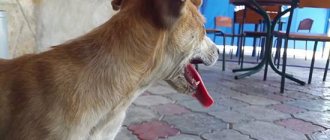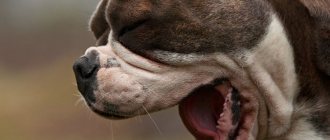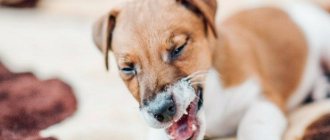If there is a dog in the family, many owners believe that it should be pampered with bones. Although later, if a dog has a bone stuck in its throat, they don’t know how to help it. Bones are believed to be very beneficial for dogs, although in reality they have little nutritional value and are dangerous to the dog's health.
Especially boiled bones must be excluded from the animal’s diet. This type of feeding provides absolutely no nutritional benefit to the dog. When a pet gnaws such a bone with its teeth, sharp small fragments are formed. If he swallows them, they can get caught in the gastrointestinal tract or the dog's mouth. Only then do the owners think about how to remove the bone from the dog’s throat in order to help their pet.
If the bones have been boiled, they split very easily during the gnawing process, forming sharp fragments that can injure the dog’s stomach, esophagus or intestines. But the most dangerous of them are fish bones. They can pierce internal organs and lead to disruption of the integrity of the intestinal walls, which can lead to surgery or death of the animal.
Physiology of swallowing
Swallowing is partly a reflex act:
- Its first phase - chewing in the mouth - is controlled by consciousness.
- The second phase is direct swallowing - a reflex act that occurs when the receptors of the root of the tongue are irritated.
- The third phase - the movement of a food coma in the esophagus - is also involuntary and occurs when the walls of the esophagus are irritated.
It is worth noting that in the second phase, when swallowing, the soft palate rises, which is why the communication of the pharynx with the nasal cavity stops. This reflex act is aimed at preventing food from entering the trachea. However, everyone knows that choking can be quite easy. This also happens in dogs, although it is rare (they do not talk while eating).
Blockage of the esophagus is a fairly rare occurrence, since the pharynx is designed in such a way as not to allow an excessively large and hard food bolus to pass through. But this is still possible, since dogs eat food quite actively and quickly. Most often, incidents occur when dogs are fed fish or chicken bones, as well as when actively playing with sticks or small objects (balls, corks).
The dog is coughing as if he was choking
You need to understand that coughing is a nonspecific sign of many pathologies, so you cannot immediately conclude that the dog is choking. First, take a closer look at the moment the cough appears. If the symptom appears in your pet while eating or when he is gnawing on something, then it is likely that he was choking. Otherwise, a cough indicates other possible diseases.
A cough must first be distinguished from vomiting:
- The gag reflex uses the abdominal muscles.
- When coughing, the muscles of the chest are used.
Also, vomiting always ends with the expulsion of vomit.
A foreign object is indicated by the cough and the absence of additional symptoms. A cough due to bronchitis or another disease is necessarily accompanied by other symptoms. When a dog chokes on grass or another object, there are no additional signs of illness. The pet was just playing and having fun, gnawing on a stick, and a second later he started coughing - this is a sure sign that the dog is choking and is coughing from this.
Typically, this type of cough ends with the object being expelled from the throat and the pet spitting it out or chewing and swallowing it again. Also, a sharp development of cough indicates a foreign object. In pulmonary diseases, the cough increases gradually, initially it is hoarse and whistling. If the dog is choking, the cough will be strong and sharp immediately, with no additional noise (whistle or gurgle).
Killer treat
Sugar bone is the number one dog delicacy. This deep-rooted misconception is persistently refuted by life. Even wolves, the predatory ancestors of man’s barking companions, leave behind “horns and legs” from the prey they eat.
What can we say about a domestic dog that is accustomed to industrial food or delicate “human” food? A bone can turn into a lethal weapon for her. Such a “delicacy” can injure the throat, lead to organ ruptures, lose teeth, and cause suffocation.
Symptoms
First you need to decide on the nature of the foreign body. When swallowing sharp or round objects, the signs of a problem and first aid are slightly different.
- When swallowing sharp bones or bits of a strong toy, the dog becomes very anxious and is not distracted by anything else. Excessive salivation occurs and vomiting may occur. Clots or streaks of scarlet blood are often found in saliva and vomit. The pet scratches its face with its front paws, as if trying to free itself from the muzzle, sometimes even gnawing on the ground (see vomiting in a dog, what to do).
- If a round foreign body (ball, nut, plug) is stuck in the esophagus, then the pet experiences frequent vomiting, drooling, and coughing. The animal may try to take food, but after a minute, with a strong vomiting movement, it coughs everything back up almost unchanged. Over time, on the second day, the animal’s anxiety may increase, and a painful reaction is observed when the esophagus is probed.
Briefly about the main thing
- Cough is a symptom, not a disease.
- Most often, this disease is divided into dry and wet, bypassing other parameters - the nature of the course, severity of manifestation, frequency.
- The most common cause is viral microflora.
- The symptom occurs in all breeds.
- Treating a symptom will not eliminate the cause of the disease, which means the symptom will return.
- The cause is identified by the doctor, and the effectiveness of treatment depends on this.
- With a strong cough, asphyxia is possible, from which the animal will die.
First aid technique for a dog if it is choking
When a dog chokes on food, the first thing to do is calm down and not panic. First, assess your pet's condition. If his tongue turns blue and breathing is difficult, then urgent veterinary help is needed. You cannot force your dog to drink vegetable oil, because the pet’s swallowing reflex may be impaired due to a foreign body. There are special techniques that will help him, but if possible, it is still better to take your four-legged friend to the veterinarian.
If it is not possible to contact a specialist, you need to help the dog cough up a foreign object. For large and small dogs, the assistance technique will be slightly different.
Big dog
If the dog is wheezing or coughing, then stand slightly behind the dog. Bend over and wrap your arms around your pet's body where the chest meets the stomach. Place the fist of your right hand under the sternum in the area where it meets the stomach. With your other hand, grab the elbow or wrist of your right hand so that both hands fit snugly against the animal's body. Then you need to forcefully squeeze the pet’s body forward and upward.
Repeat the compression until the dog coughs up the foreign object. After this, it would not hurt to remove the foreign body from the mouth so that the pet does not choke on the bone again. Usually 3-6 pressures are enough for the dog to cough up the bone or food. If you have repeated the movements 10 times already, but there is no result, then urgently call a veterinarian at home.
Little dog
If a small dog is choking, then it needs to be placed on your lap and pressed with its back to your chest. Place the fist of your right hand at the junction of the sternum and the stomach, and it is advisable to hold your head with your left hand. Push sharply forward and upward with your fist several times. Also, after coughing up an object, it is advisable to remove it from the pet’s mouth.
Life without risk factors
Seeing a four-legged pet wheeze and suffocate is unbearable. The simplest preventive measures will help prevent misfortune:
- exclusion of any bones from the pet’s diet;
- prohibition of vagrancy, which is fraught with the search for “prey” in the form of inedible and dangerous foreign bodies.
Remember, bones are a cheap product that can cost you a lot. Block his path to the dog bowl forever - and he will not know grief. Pamper your pet with safe chewable treats from the pet store.
When it doesn't work out
If there is no desired result from the above actions, palpate your pet’s esophagus. If a foreign body in the form of a compaction is felt at the very beginning of the esophagus, then it may be possible to remove it with tweezers. Otherwise, you need to take your pet to the veterinarian.
The dog's mouth is opened with the handle of a spoon or fork and the root of the tongue is pressed. The dog's head needs to be held firmly; it is better to ask for help, as the procedure is unpleasant and the pet will struggle. Then they try to grab the stuck object with tweezers. The entire procedure is carried out carefully so as not to inadvertently push the foreign body even further. Also, you should not pull out the object with a jerk, as you can damage the esophagus.
After removal, continue to monitor your pet. If your dog shows extreme anxiety when swallowing and blood clots are found in the saliva, you should contact your veterinarian. Also, if you cannot remove the foreign body, you must immediately take your pet to a specialist.
Author:
Grinchuk Ekaterina Andreevna veterinarian
Main causes of difficulty breathing
Entry of a foreign body into the respiratory tract
Dogs are naturally curious creatures, so they tend to put various objects in their mouths that can play a cruel joke on them. Stuck in the throat, various little things can lead to suffocation, as a result of which the dog begins to choke and wheeze. This often happens during play, when a pet is chasing a ball, stick or other toys.
But another common reason for a dog choking and coughing can be food if it was swallowed greedily or simply went “down the other throat.” A dog can choke on too large a piece of meat, as well as on a fish or meat bone that is stuck in the throat, or even on dry food.
Some dog breeds are distinguished by their special speed in eating food, regardless of the degree of their hunger - they always eat this way, trying to get enough as soon as possible. A very hungry animal or pet, which the owner leaves for a long time without food, greedily pounces on food as soon as it is given to him. And it is not surprising that it ends up in the windpipe or gets stuck.
A four-legged pet can even die from a bone stuck in the throat; in addition to a fish bone, this situation can also be caused by a piece of large meat muscle, large, albeit soft, cartilage, as well as tubular bones.
Both an adult and a puppy can choke on dry food. Particles of such food, being moistened with saliva, are compressed into too large a piece and simply get stuck in the throat. When coughing, the dog makes sounds as if it was choking, but cannot spit out the stuck lump. It is better to choose dry food in the form of large granules. The pet will be forced to chew them before swallowing them.
We advise you to read: Hypoallergenic Dog Breeds.
Owners who keep several representatives of the dog family, as well as owners of shelters and kennels, know well what competition between animals is. Among the dogs there are many who try to quickly eat their own portion in order to have time to enjoy the contents of their neighbor’s bowl. This concept of behavior often represents a principle of survival, which manifests itself even when the dog is in favorable conditions and receives sufficient food. But with these smaller “eternally hungry” brothers, situations where they choke on food in a hurry happen quite often.
The cause of a cough can also be a cold or an inflammatory disease, as a result of which the dog does not choke on anything, but his throat is sore and severe dryness is felt, causing a cough, with the help of which the dog tries to relieve the irritation. In such cases, it is necessary to treat the underlying disease, and after recovery the cough will disappear.
Breed predisposition
Pets of dwarf breeds, as well as brachycephals, are characterized by a special structure of the pharynx and respiratory apparatus. This anomaly is considered congenital - due to the soft palate, a sharp sip or inhalation leads to contraction of the larynx. At this moment, the palatal tissues block the airways for a short moment, and the dog gasps and wheezes as if he was choking. Fortunately, the problem resolves itself after a few seconds.
Brachycephalic syndrome in four-legged animals is expressed in noisy breathing, up to wheezing or snoring in a calm state.
At night, the dog may snore quite loudly, he is forced to take special positions during sleep, and he may often experience shortness of breath and other symptoms.
Chest trauma
Most of the injuries that a four-legged friend receives in various negative situations - be it a bite from a larger individual, an accident involving a fall from a height or being hit by a car - are characterized by damage to the chest and the organs located in it. Such injuries can be accompanied by an accumulation of air in the animal’s chest, which also leads to breathing problems - the dog cannot breathe and in such a situation cannot be avoided without medical intervention. Sometimes it is enough to remove the air through a small puncture; in more complex cases, surgery is required.
Tracheal collapse
Breathing problems are not uncommon in small breeds such as Chihuahuas. Various developmental defects, congenital or acquired, lead to the fact that the soft tissues of the trachea become inflamed and softened. And then the dog coughs, as if choking, she experiences shortness of breath, and while eating, vomiting may occur. As a result, the dog may begin to refuse food and water.
The danger of tracheal collapse is that without timely help, the dog may even die from suffocation. In unadvanced cases of the disease, medications in the form of special nutritional supplements help, with the help of which the tracheal tissues are restored. If the situation is more complex, then surgery is performed.
We advise you to read: How to strengthen your dog’s joints and ligaments











